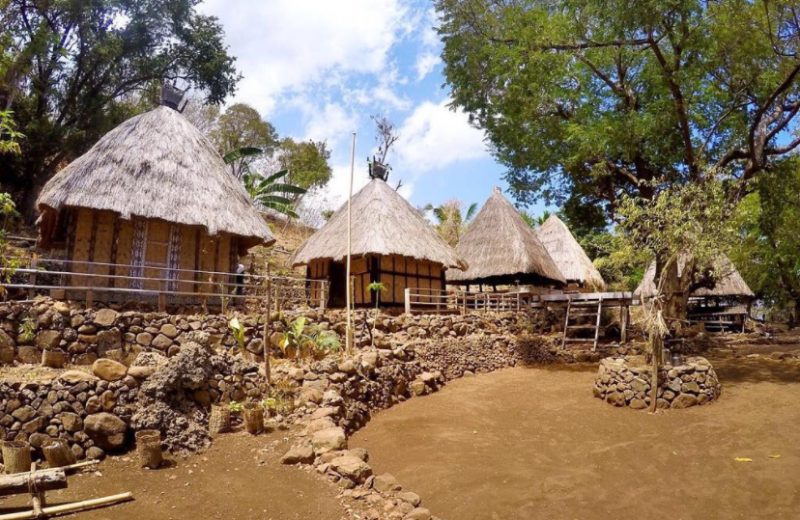Authentic and Tranquil Experience on The Off-The-Beaten-Path of West Timor

People have said, that the further you go to eastern Indonesia, the more nature and scenery become more stunning. No wonder, some destination located in East Indonesia has been increasingly popular for tourists. Labuan Bajo, Sumba island , Flores Island, and Lombok Island are some of it. But what about Timor Island? The island split into Indonesia's East Nusa Tenggara province and the small state of Timor Leste offers a unique and diverse range of attractions and experiences for travelers.
West Timor offers a blend of cultural immersion, natural beauty, and unique traditions that make it an intriguing destination for travelers looking to explore a lesser-known part of Indonesia. It's a place where you can experience the diversity and authenticity of the local way of life. The island boasts stunning landscapes, including rugged coastlines, mountains, and lush forests. Its crystal-clear waters are home to diverse marine life and colorful coral reefs, offering opportunities for diving and snorkeling. Meanwhile, its cultural diversity, traditional villages & crafts, and the friendliness of the locals will bring you a more authentic and tranquil experience on the off-the-beaten-path of Indonesia.
Here are several attractions and activities you can enjoy in West Timor:
1. Oebelo
Oebelo is a village located in the East Nusa Tenggara province of Indonesia, on the island of Timor. It is particularly renowned as the home of the traditional musical instrument known as the "Sasando.” Oebelo is a significant center for the production and preservation of Sasando, a type of bamboo harp or stringed instrument native to the island of Timor.
Oebelo has become a popular destination for tourists and travelers interested in experiencing Timorese culture and the art of Sasando-making. Visitors can learn about the instrument's history, watch demonstrations, and even try playing the Sasando themselves. A visit to Oebelo provides a chance to immerse yourself in the rich cultural heritage of East Nusa Tenggara and witness the craftsmanship and artistry of Sasando-making. It's an excellent place to appreciate the traditional music and crafts of the Timorese people while engaging with the local community and experiencing their warm hospitality.
2. Traditional houses of Timor "Lopo".
The "lopo" is a traditional house found in Timor, an island shared by two countries, Timor-Leste (East Timor) and Indonesia. The lopo, also known as "uma lopo" or "rumah lopo" in Indonesian, is a distinctive type of traditional dwelling that reflects the cultural heritage and way of life of the Timorese people.
Lopo houses are characterized by their unique architectural design. They typically have a circular or oval shape, with a thatched roof made from palm leaves or grasses. The walls of the lopo are often constructed from bamboo, wood, or woven materials, allowing for natural ventilation. The circular shape is believed to have cultural and symbolic significance.
3. Traditional village Boti
Boti is a traditional village located in the West Timor region of Indonesia, specifically in the Amanuban subdistrict of the South Central Timor Regency. Boti is renowned for its commitment to preserving its unique cultural heritage and traditional way of life.
Boti is known for its isolation from modern influences and its dedication to preserving its traditional customs and beliefs. The village has intentionally limited outside contact to safeguard its cultural identity. Unlike in most parts of Indonesia, the people of Boti adhere to traditional animist beliefs, which involve the worship of ancestral spirits, and nature, and the practice of rituals and ceremonies. These customs are deeply rooted in the daily life of the villagers. Meanwhile, the traditional houses in Boti, known as "Uma Mone," are constructed using thatched roofs and bamboo or wooden walls. These houses are designed to be easily dismantled and moved, allowing the community to periodically relocate within the village. The village has a subsistence-based economy, with limited access to modern amenities. Trade is often conducted through barter systems, exchanging goods like woven textiles, agricultural products, and traditional crafts.
Boti has gradually become a destination for travelers interested in experiencing authentic Timorese culture and traditions. Visitors can learn about the village's unique way of life, participate in traditional ceremonies, and purchase locally-made handicrafts.
4. Fatumnasi
Fatumnasi is a beautiful and remote village located near Mount Mutis in West Timor, Indonesia. Mount Mutis, also known as Gunung Mutis, is the highest peak on the island of Timor and is part of the Mutis Mountain Range. It's a destination that appeals to nature enthusiasts, hikers, and travelers interested in authentic cultural experiences.
Fatumnasi is surrounded by lush forests, rolling hills, and pristine landscapes. The area is known for its incredible natural beauty, with opportunities for hiking and exploring the scenic wilderness.
5. Bonsai Forest
This bonsai ampupu forest is located in Timor, an island at the eastern tip of East Nusa Tenggara (NTT) province, with an area of 30,777 square kilometers. The bonsai forest containing ampupu trees is specifically situated in the village of Fatumnasi, Fatumnasi sub-district, South Central Timor Regency (TTS). For the Dawan people, the indigenous ethnic group inhabiting the Fatumnasi region, this bonsai forest is referred to as "akuna."
The tourist attraction is a natural green forest filled with thousands of ampupu trees, scientifically known as Eucalyptus urophylla, aged hundreds of years. These rows of ampupu trees form a green canopy, not more than 2-5 meters in height, with distinctive roots and trunks that are large and curvy, resembling a dancer. At first glance, these ampupu trees appear to have undergone dwarfing or bonsai-like processes. Their branches extend and touch each other, creating a unique, interconnected appearance, and they have small-sized leaves. Under extreme conditions, ampupu trees can only grow as shrubs, not exceeding 2 meters in height.
6. Niki Niki, the residence of King Nope, one of the Timor’s King.
Amanuban was a traditional princedom in West Timor, Indonesia. It lay in the regency (kabupaten) Timor Tengah Selatan. The center of the princedom since the 19th century was Niki-Niki. The population belongs to the Atoni group.
The princedom has been known for its resistance toward the Dutch. The last independent king of Amanuban, Bil Nope alias Hau Sufa Leu (c. 1870–1910) befriended the encroaching Dutch colonial authorities in the early years of the 20th century. However, the arrogant stance of the local Dutch officer caused anti-colonial resistance. Finally Bil Nope died in the flames of his residence in Niki-Niki in October 1910. In modern Indonesia, he is regarded as an anti-colonial hero, and his residence becomes a tourist attraction.
Dada Sabra S.
Log on theislandgirladventures for more interesting travelstories
image by Tripadvisor
-----------------------------------------------------------------------------------------------------------------------------------------------------------------
Intrested in visiting this amazing sight ? Check out what Perama Tour Have to offer !
